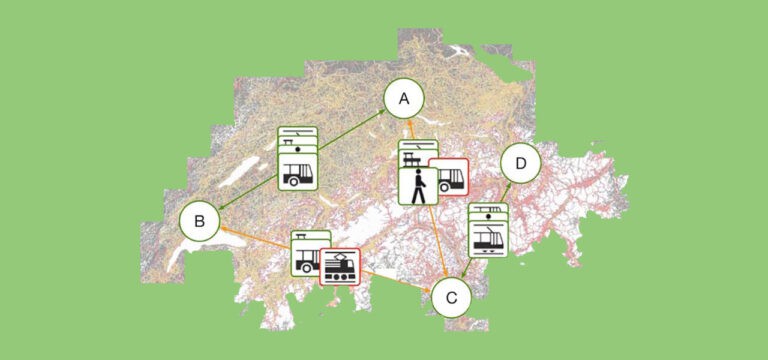As of beginning of 2016, smartwatches are beginning to find their place in the daily behaviour of consumers, mostly as an accessory, despite the fact that a “killer application” has yet to be found.
Apps are dead, long live Apps
- No land for old apps
The size of the screen changes the usage of an app. Except for a few categories (e.g., fitness, maps), most of apps are yet to find compelling user experiences - Time and bit-sized information
The watch is mainly used to refer to the information always present on the dial. That is the hour, but also those that are put on the watch face as “complications” (calendar, temperature, etc.) - Only streams are worth a glance
“Glances” are used very little, and effective use cases are mostly yet to be found. Notable exceptions are glances which offer streams of information (e.g., turn by turn navigation). - Notifications are the #1 reason to use a smartwatch
The most used feature are notifications. In the current state of the development frameworks, these cannot be fruitfully modified.
Background
2015 has been the year in which the market of wearables has exploded. The trigger has been the release of the AppleWatch, and the maturation of the products of Fitbit, Samsung, and Google. Although wearable technology has been available for many years, what was largely missing were ecosystems to make their use seamless.
Swatch, for instance, has explored ways of making watches with interactive functions for years, attempting to sell a watch that served as a mobile phone early last decade. Then in 2004, Swatch Group teamed up with Microsoft to launch a smartwatch called Paparazzi that offered users subscription-based access to news, horoscopes, stock quotes and other real-time information via FM radio broadcast waves. In 2005, a high-end version, the Tissot High T, followed suit. Despite the partnership, neither product met the hoped-for success, and created a bad precedent for the watch industry, which has since then been mostly conservative.
The erosion of traditional watch sales in 2015 across all segments (source: http://www.fhs.ch) are worse than what the analysts expected, which is that smartwatches would only threaten the middle and low segments.
The Search for a Use Case
Smartwatches are beating market projections mostly because no one could figure out beforehand what the “killer app” would have been. At Ex Machina we anticipated that a clear atomic use case for a smartwatch wasn’t a prerogative for success. The reason for our correct prediction was mainly that the same happened with the iPad (side note: that was not the case for the iPhone, as it was introduced mainly as a phone, web browser, and music player).
Nonetheless, marketing efforts continue to tentatively hit on certain notes in the quest for increasing sales, which is a good indicator of the use cases that are dominating. As of beginning of 2016, the smartwatches are mostly used for notifications, keeping track of physical activity, and atomic actions, such as replying to a text message with templates and showing boarding passes as QR codes.
The Disappointment of the Devs
The release of SDKs for smartwatch apps has created excitement for developers, anticipating a “gold rush” like that of smartphone apps. Unfortunately, the expectations weren’t matched. Not because the user base is small, but because apps on a smartwatch are substantially different than on a smartphone or tablet.
One of the biggest factors is that the screen is too small to allow for the complete experience a smartphone provides. In particular, it is too small play games, which is a major driver of app sales and in-app purchases. It is also too small for another popular incentive: showing traditional advertisements. The small size creates a hyper-competitive environment whose potential-vs.-effort ratio disincentives developers.
Another important factor is that the default mode for a smartwatch is still “locked” (i.e., showing the watch face. Also “glances” are hardly used), compared to a smartphone where the default mode shows the grid of apps, all screaming for attention with careful design. This means that starting and maintaining a habit of using an app is harder, even if an app is worthy. The element that could mitigate this problem are the digital complications, which fit on the watch face, remind of the underlying app, and allow accessing it directly.
In other words, what is still in its infancy as a concept —and developers need to realise this— is that the usage of a smartwatch is substantially different than a smartphone. This means that it is likely that in 2016, backed by the improvement of the SDKs, new forms of interactions will appear, which will exploit the new user behaviours. One trend appears clear though, apps won’t be at center stage for much longer, although they will be needed to mediate these new forms of interaction.
Notifications
One functionality that stands above any other when it comes to smartwatches are notifications. Notifications on the wrist are a gate that trigger or not the need to look at the smartphone. This means that the smartphone doesn’t need to be in view any more, it can be left anywhere in range. This is a remarkable aspect that shows the potential of smartwatches: it changes the behaviour of the user. These are the kind of aspects that developers need to be considered, a lens through which designing apps.
For instance, notifications are the reason why maps and navigation apps are popular on smartwatches: they simply notify the user when to turn. Or again, a football app that alerts the fan when a goal has been scored, triggering the question: “Do you want to watch the replay right away on your smartphone?” The common thread for successful notification-based apps is that they provide timely information in our daily stream of activities. The higher the relevance and timeliness, the more valuable the app.
The Road Ahead
Wearables and smartphones provide valuable punctual functionality, but the greatest opportunity lies in using them as portals to remote streams of information. While apps used to be perceived as rather unsophisticated pieces of software, they are now becoming more and more powerful by accessing vast quantities of data and computing power. The rise of more capable algorithms and Machine Learning systems —coupled with proper Design— make this power valuable through simple, user-friendly interfaces. Hence, the winners of tomorrow’s app economy —especially for wearables— will be providers of deep solutions that are able to combine their data with external sources through powerful processing systems to go beyond the device’s sensing, storage, and computing capabilities.
Additionally, wearables are making body movements and identified presence interesting again for developers. Like the Nintendo Wii before, wearables will allow using natural gestures for remote control of physical devices (e.g., flying a drone) and virtual interaction. The latter is particularly interesting in the context of Virtual and Augmented Reality because a wearable device can serve as a natural input system. Moreover, the position of the most popular wearables on the wrist makes them well suited for identification-based control (e.g., payments, computer or car unlocking). Finally, the combination of identification and gestures with localisation simplifies context-relevant information display through automatic app selection. Accessing the physical world at higher resolution, in a personalised way, is opening new dimensions and opportunities.
The small size of wearables will thus be compensated by increased intelligence from remote information and concise experience design. The structure of the usage indicates that the road ahead is one of deep solutions across different technological ecosystems.
Nicola Rohrseitz & Lorenzo Pino



